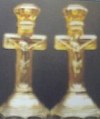Carnival Glass 101 | home Quick Reference to Carnival Glass Patterns on This Site
Imperial - Part 9
1910 - IMPERIAL PATTERNS
100 YEARS OF PRESERVATION and ADMIRATION!
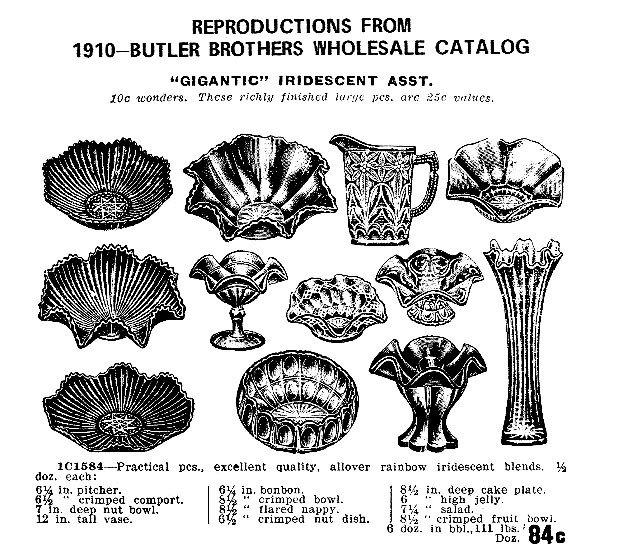
1910 Butler Brothers Wholesale Catalog Ad
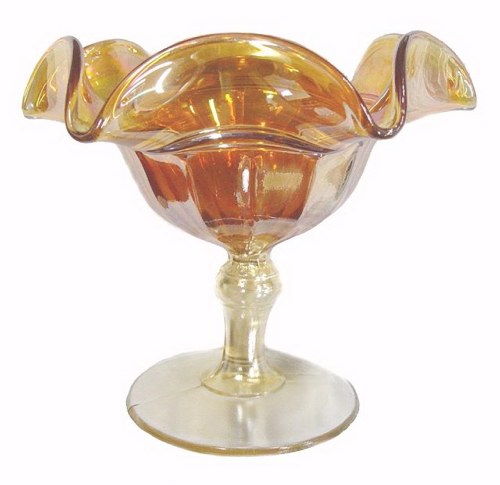
BANDED FLUTE- 1910 Compote.
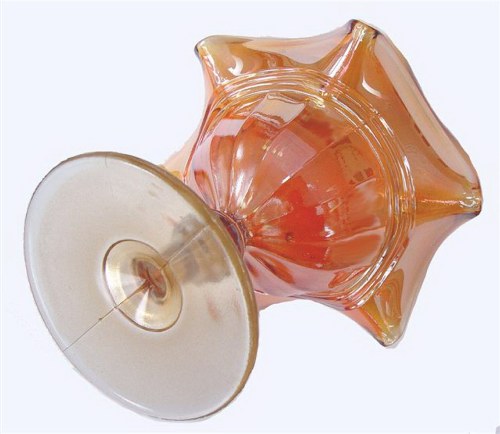
BANDED FLUTE Compote - 2-Part Mold
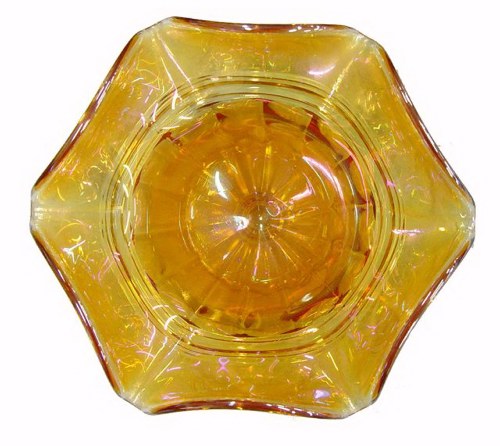
BANDED FLUTE Interior-Smooth.
BANDED FLUTE: Art and Barbara True provided us with a photo and a 1910 Butler Bros. Ad displaying this compote among other known Imperial patterns, included in (Presznick's Book IV, page XVI.) They had found the (then un-named) compote in 1997 and asked us to write an article about it for the June 1998 San Diego Club Newsletter after discovering that it was not listed in any of the updated reference books.
Since the Poinsettia pitcher, Freefold vase, Oval and Round rose bowl, two Star of David bowls, the Columbia vase, Plain Jane and Smooth Rays bowls, Three in One, Rococo and Optic Flute patterns are identifiable in this 1910 Ad, the True's believed this newly found compote to be an Imperial product.
It has a spectacular radium finish, is a two-part mold and has no pattern on the interior of the bowl. Exterior design is an inner band of glass somewhat larger than the smaller band on each side of that. Extending downward to the stem are 14 tapered panels. It is 4 ¼” high, with a 6” ruffled span. Barbara noted the stem and base to be clear. Marigold is the only known color. (It appears to be a design somewhat difficult to remove from the mold without damage, resulting in small production results?) Perhaps only a turn (400) or more likely, a half turn (200).
(We had seen a duplicate of this same compote in the late Bob Gallo's room while attending the 1998 HOACGA Convention). Bob called it Banded Flute, and some other responses offered the same pattern name. We ask that you be in touch with us should you have knowledge of other such examples. To date, we know of only a possible three compotes.
To quote John Resnick, the latest and first of these to sell at auction, during the Jan. 2010 Wroda sale in Greenville, OH for a nominal $7.50!!!! - a truly Rare-So-What! This is a prime example of an unknown rarity. Until any piece assumes that “rare” status through exposure to the collectors, repeated desirability cannot be attained. Incidentally, the stem and base of this compote is light marigold.
Some collectors enjoy owning the most expensive specimens available, while others take joy from the simpler and more unusual items. Presumably, if we all liked the same pieces, much of the glass would not sell, would it?
NOTE: Our original Butler ad supplied by the True's had become terribly blurred from over-use. Jerry and Carol Curtis very kindly supplied us with this nice, clear, freshly taken replacement.
10-13-2017
Lauren Bush has recently found the second Banded Flute compote.
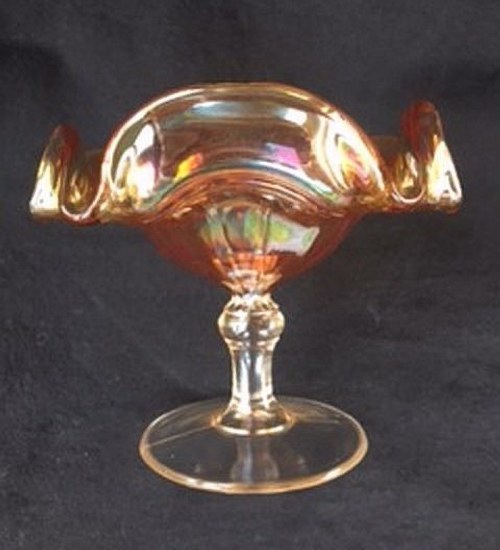
Banded Flute Compote. Courtesy of Lauren Bush.
Banded Flute Update
May 26, 2018
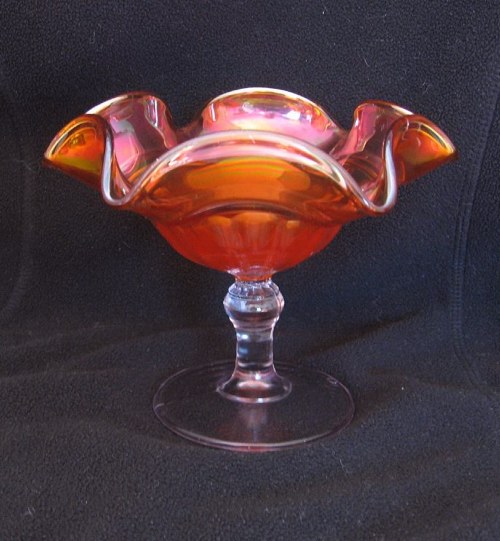
Banded Flute Compote. Courtesy of Ian Willams
Ian Williams found a BANDED FLUTE compote with a rough edge on the foot, but not from damage.
It is from a two-piece mould. The clear stem and foot have a slight purple/lavendar tinge (perhaps
from sitting in sunlight?) and exhibits a faint green glow when subject to UV light. The stem has a
slight twist confirmed by the deformed mould lines. The foot has a bubble near the edge but is
internal and completely smooth.
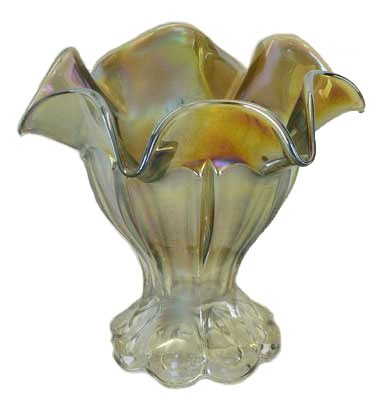
COLUMBIA Vase in rare Smoke
COLUMBIA Vase: Listed as Imperial's #246 pattern in factory catalogs, 16 shapes were produced in non-iridized crystal. vases, bowls, compote, rose bowls, and a flat plate. The stemmed compote was a separate mould. All shapes are more frequently found in marigold, with vases and compotes more abundantly available. Bowls, 7”-8” are scarce, and the plate, 7 1/2”-9” is rare! Only a couple of rose bowls are known. Bowls and the rose bowls are known only in marigold. Vases have been reported in marigold, smoke, helios, and purple. All but the marigold are rare with purple examples topping the list. Iridization on all shapes is usually of excellent quality. The vases are 5”-7” in height.
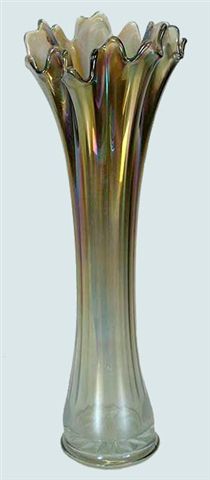
12 in. FREEFOLD Vase in Smoke.
FREEFOLD Vase: These vases range from 7”-14” in height and although not as abundant as some other vase patterns, marigold, lavender, helios, purple, clambroth, smoke and white examples are known. Lavender vases seem more frequently found. Purple and marigold are not too difficult to locate, but the other colors are not seen often.
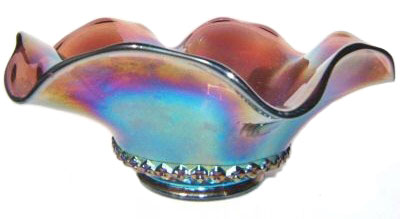
OPTIC FLUTE 7 in. bowl in Lavender.
OPTIC FLUTE: Although not seen very often, this pattern is represented in marigold and clambroth compote shapes, along with berry sets in marigold, clambroth, purple and smoke. The bowl sizes are 8”-9”, with small sizes, about 5”.
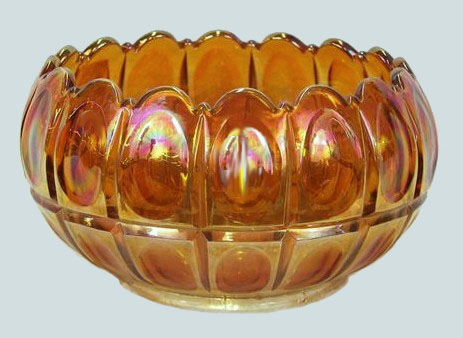
OVAL and ROUND Rosebowl
Courtesy Wroda Auctions
OVAL and ROUND: Listed in early Imperial Catalogs as #89 when produced in early crystal. Similar in aspect to Three Row and Two Row vases, Oval and Round items are not often found. A berry set, consisting of the master bowl of 8 ½” and smaller 4 ½” bowls in marigold, purple, helios, and amber, along with a rare rose bowl in marigold and a really rare 10” chop plate in marigold and amber, comprise the shapes known in carnival glass. (We once owned a marigold chop plate and regret having sold it, now that we concentrate on chop plates.)
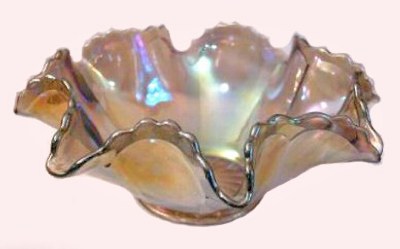
PLAIN JANE in Smoke - 9 in. diam. - 18 Pt. Star & 12 panels.
PLAIN JANE: Mrs. Hartung is to be congratulated for placing this appropriate name upon a likely candidate! There is a faint Wide Panel design on the exterior, but the slightly scalloped edge and the large star within the marie are the only other “character traits” this piece is blessed with! Depending upon the flare, the bowls can vary from 7”-9”. Marigold and smoke are the colors for bowls.
Handled baskets, which will be shown in a coming segment are the only other shape found in this pattern.
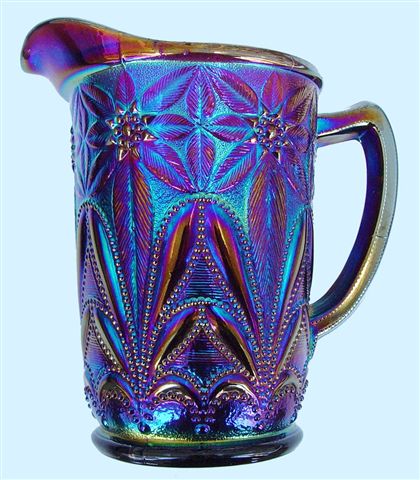
Need we say this is Purple - POINSETTIA.
POINSETTIA Milk Pitcher: These 6” tall pitchers command attention wherever they present themselves! Marigold is the dominant color, followed by helios; (and they are scarce). Smoke is a rare color, with the purple pitchers being very rare and precious to their fortunate owners. Emerald green is said to be breathtaking, but over the many years we have been involved with carnival glass, we can truthfully say we have never seen one!
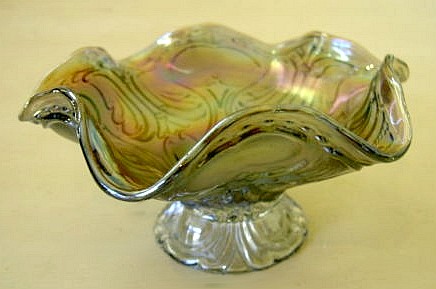
ROCOCO Bowl - 5.5 in. in Smoke. Dates to 1910.
ROCOCO Bowl: 1910 is the earliest documented appearance of this pattern. A 5”-6” vase in marigold, smoke and lavender, along with 5”-6” dome-footed bowl, along with a 9” dome-footed bowl in marigold. All shapes are from the same basic mold.
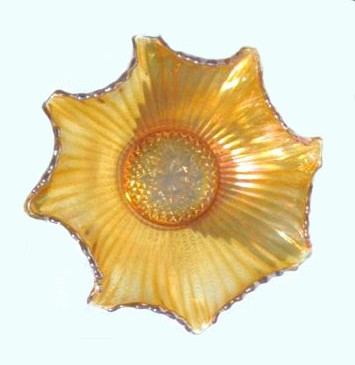
Imperial's Smooth Rays bowl.
SMOOTH RAYS Bowl: Confusion reigns unless distinction away from the Westmoreland Smooth Rays pattern is made. Old Imperial factory catalogs indicate this line to be a combination of four different pattern numbers: #M-345, #M-399, #M-422, and #M-755. Some examples of Smooth Rays are signed with the Imperial Iron Cross mark.
Shapes and Colors known:
Other Shapes:
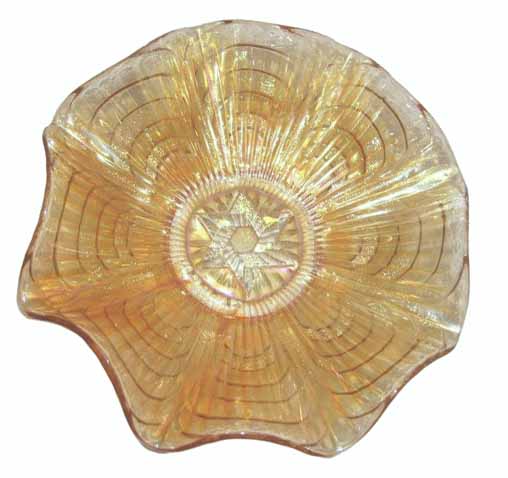
STAR OF DAVID 9 in.- Marigold.
STAR of DAVID: Patterns found on only one shape are quite nice to collect. These 8”-9” bowls can be ice cream shape or ruffled, and the exterior pattern is Arcs! One of few Imperial patterns more prevalent in purple, the iridescence is typical radium. Helios examples are fairly easy to locate, with marigold bowls requiring more determination to obtain. Smoke is quite difficult, with few examples known.
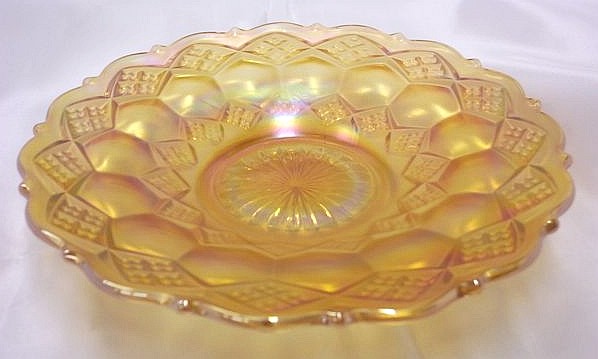
THREE in ONE 6-7 in. Plate
Courtesy Ardonna Bucher.
THREE in ONE: Ardonna Bucher provided this photo of the rare little 6”-7” flat plate. They have been reported only in marigold. This pattern is distinguished with the factory designation as their #1 design dating from 1904 when it was produced in a wide variety of non-iridized crystal shapes. After 1909 factory catalogs offered fewer shapes in the design. The number of carnival shapes is limited. In addition to the plate, rarer marigold rose bowls shaped from the 8” bowl mold are known. Bowls in 4” and 9” sizes: marigold, purple, helios, smoke and clambroth are confirmed.
Controversial as they are, old toothpick holders in marigold are very rare. When it comes to the green ones: NEW examples clearly marked IG were made in 1968. Again in 1978 after Lenox bought Imperial, paper labels were used for more reproductions. These labels can be easily removed and come off over time. We are now some 32 years beyond the original application of those labels at the factory. Belief is strictly within the discretion of the beholder, but speaking from the heart: we would not spend too much hard-earned money to own a green one!
Dean & Diane Fry - 3-10


C.S. Lewis in his The Abolition of Man, cited a wide range of civilizations whose core beliefs
are in agreement with the Ten Commandments.
“When Gentiles, who do not have the law, by nature do the things in the law,
these, although not having the law, are a law to themselves, who show the work of the law
written in their hearts, their conscience also bearing witness,
and between themselves their thoughts accusing or else excusing them” (Romans 14-15).
Those who oppose the self-evident moral guidance provided by the Ten Commandments
do so in opposition to the law of God written in their hearts.


“All Scripture is given by inspiration of God” (2 Timothy 3:16). The word all can also be translated “every”.
This means that Scripture is inspired “in the whole and in the part”. Whether it be the laws of Leviticus or the Acts of the Apostles, all of it is inerrant and given by inspiration of God.
The Greek word we translate as “inspired” is theopnuestos-literally, “God-breathed.” All of it is profitable to the believer.
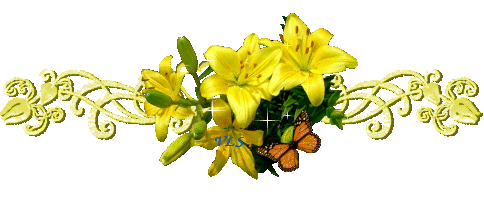
Should you care to contact the Frys, their email address is:
Search Carnival Glass 101
back to Carnival Glass 101
Our other sites you may enjoy:
Everything you EVER wanted to know about Indiana Glass
Great Reference for Newer Carnival Glass.
Complete Glassware Catalogs Available to Download
Questions? Comments? Suggestions? Broken Links? Corrections?
Your Friendly Webmaster is here to help!
